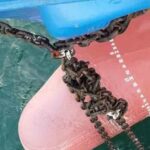Real Life Accident: Ship’s OS Dies Because Of Poor Mooring Practice
Before arrival, the Master conducted a meeting to brief officers on the mooring plan and the constraints at the port. The vessel, an 85,000 ton bulk carrier, is provided with 16 mooring lines on mooring drums. As it was, the vessel was not accommodated along her full length of 287 metres at the berth; her aft section was to overhang the end of the berth by about 20 metres. The plan was to berth the vessel 6-3-3 forward and aft. This mooring could be achieved by doubling the existing ropes and the mooring plan agreed with the pilot.
The lead of all mooring lines was relatively short as the vessel was not berthed with her full length alongside the berth. The Master protested to the agents and charterers immediately after berthing about the inadequacy of moorings and the unsafe conditions for rigging the gangway.
Sometime after berthing it was observed that the vessel’s bow had come off the berth by about one metre. The third mate and an OS proceeded to the forecastle deck and the second mate and one AB proceeded aft. To bring the bow alongside, the third mate heaved on the starboard breast line and second mate slackened the stern lines. Then third mate proceeded to heave up a head line and the OS was asked to heave up the starboard breast line. Within 10-15 seconds of the OS being asked to heave up the starboard breast line a loud sound of parting rope was heard. The third mate immediately came to the starboard side where he observed the OS, prone and bleeding between the mooring winch and the control stand.

The broken mooring rope was a 70mm diameter polypropylene monofilament 8-strand plaited rope and on visual examination found to be in general good condition. The rope was found to have parted at a point about 14 metres from the eye. As a result of being hit on the head by the parted breast line the OS was declared dead at the hospital that same evening.
Contributing factors
- The OS, although holding a qualification as an Efficient Deck Hand (EDH) and having been given awareness training for the mooring equipment on this vessel had only recently been promoted to OS from steward. He had little experience of tending to the moorings of a large vessel in such difficult environmental circumstances.
- The plan of mooring equipment at forecastle deck shows that the breast line is passed through the pedestal roller fitted aft of the mooring winch on deck. In this arrangement the winch operator’s position is in the snap back zone of the breast line.
- It is likely that the OS did not realise that he was standing in the snap back zone for the rope he was hauling as the snap back markings were no longer clearly marked on deck.
- The head line that the third officer was hauling was approximately twice the length of the line that the OS was working, already pretensioned during initial efforts to bring the ship back alongside. Although the ropes were of similar materials it is likely that the shorter length of rope acting as the breast line began taking on a breaking load while the forward head line was still taking up the elasticity of the rope.
- The lead of all mooring lines was relatively short. This reduced the length of wharf available. The vessel was also unable to heave on her stern lines and bow lines simultaneously to keep the vessel alongside as the overhang would have resulted in the stern moving in and the bow moving out.
- Coordination between the terminal, pilots and the vessel was poorly managed and did not provide for safe berthing of the vessel. The issues with inadequate mooring arrangements, safe access and egress and the commercial pressures of starting cargo operations all stretched senior management onboard. This resulted in confusion, incomplete preparation and inadequate shore-to-ship coordination. This failure also carried over to the following evening when another rope failed at the next high flood tide. This time the rope was not being attended to.
- Given the size of the ship, reduced wharfage and tidal currents, the most appropriate action would have been to have a tug standing by during the manoeuvres.
- The snap back zones have been re-established and now include the pedestal fairlead position. All fairlead rollers at the forecastle deck have been de-rusted and painted to smooth the surface.
- Crew educated on the snap back zones at forward and aft mooring stations.
- A campaign on mooring safety has been carried out in the company fleet. Every vessel in the fleet reviewed their mooring arrangement and prepared a risk assessment for mooring as per fitted mooring arrangement and in normal weather conditions. The countermeasures to these hazards were also identified. The quality and quantity of mooring ropes required for each vessel must be identified and documented.
Reference: nautinst.org
Do you have info to share with us ? Suggest a correction
- Real Life Incident: Vessel Collision in Good Visibility
- Real Life Incident: Severe Injury To Deck Crew While Leaving Berth
- Real Life Incident: Departure Damage in Very Restricted Waterway
- Real Life Incident: Low Situational Awareness Has High Impact Consequence
- Real Life Incident: Fouled Anchor in a Designated Anchorage
- Real Life Incident: Fire On Barge Carrying Scrap Metal Causes $7 Million Worth Of Damage
Latest Case studies Articles You Would Like:
Subscribe To Our Newsletters
By subscribing, you agree to our Privacy Policy and may receive occasional deal communications; you can unsubscribe anytime.

















Hello good evening sir my is emonena John live in portharcort. Working at marine engineering looking for the position of power in ur well company sir.